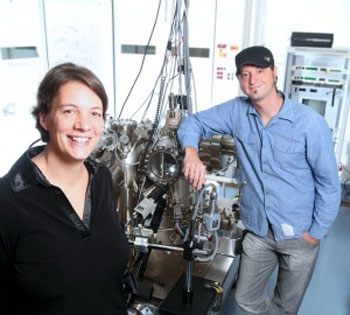| Jan 07, 2012 |
Nanotechnology shrinks conducting wires to atomic scale (w/video)
|
|
(Nanowerk News) The narrowest conducting wires in silicon ever made – just four atoms wide and one atom tall – have been shown to have the same electrical current carrying capability of copper, according to a new study published today in the journal Science ("Ohm's Law Survives to the Atomic Scale").
|
|
Despite their astonishingly tiny diameter – 10,000 times thinner than a human hair – these wires have exceptionally good electrical properties, raising hopes they will serve to connect atomic-scale components in the quantum computers of tomorrow.
|
|
"Interconnecting wiring of this scale will be vital for the development of future atomic-scale electronic circuits," says the lead author of the study, Bent Weber, a PhD student in the ARC Centre of Excellence for Quantum Computation and Communication Technology at the University of New South Wales, in Sydney, Australia.
|
 |
| Michelle Simmons and Bent Weber from UNSW.
|
|
The wires were made by precisely placing chains of phosphorus atoms within a silicon crystal, according to the study, which includes researchers from the University of Melbourne and Purdue University in the US.
|
|
The researchers discovered that the electrical resistivity of their wires – a measure of the ease with which electrical current can flow – does not depend on the wire width. Their behaviour is described by Ohm's law, which is a fundamental law of physics taught to every high school student.
|
|
"It is extraordinary to show that such a basic law still holds even when constructing a wire from the fundamental building blocks of nature – atoms," says Weber.
|
|
The discovery demonstrates that electrical interconnects in silicon can shrink to atomic dimensions without loss of functionality, says the Centre's Director and leader of the research, Professor Michelle Simmons.
|
|
"Driven by the semiconductor industry, computer chip components continuously shrink in size allowing ever smaller and more powerful computers," Simmons says.
|
|
"Over the past 50 years this paradigm has established the microelectronics industry as one of the key drivers for global economic growth. A major focus of the Centre of Excellence at UNSW is to push this technology to the next level to develop a silicon-based quantum computer, where single atoms serve as the individual units of computation," she says.
|
|
"It will come down to the wire. We are on the threshold of making transistors out of individual atoms. But to build a practical quantum computer we have recognised that the interconnecting wiring and circuitry also needs to shrink to the atomic scale."
|
|
Creating such tiny components has been made possible using a technique called scanning tunnelling microscopy. "This technique not only allows us to image individual atoms but also to manipulate them and place them in position," says Weber.
|

